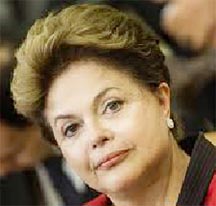BRASILIA (Reuters) – A quick belt-tightening, and then back to business as usual.

That appears to be the strategy in coming months for Brazil’s newly re-elected President Dilma Rousseff, who is trying to win back the business community’s confidence without sacrificing her leftist agenda of reducing poverty and ensuring a strong state presence in the economy.
Since narrowly winning an Oct 26 runoff, Rousseff has fuelled hopes of a market-friendly shift by allowing the central bank to raise interest rates, which surprised investors and should help control inflation running above 6.5 per cent a year.
Local press has also percolated with talk that Rousseff will make a large cut to budget spending, and that she is looking for a more market-friendly replacement for long-serving Finance Minister Guido Mantega.
Investors are eager for any signs of change after Rousseff’s first term in office, which was marked by average annual economic growth under 2 per cent, rising budget deficits that threaten Brazil’s investment grade credit rating, and huge losses for many financial investors.
Yet comments by Rousseff’s chief of staff Aloizio Mercadante, who is among the possible candidates to run the finance ministry, were one of several recent signs that hopes for a profound change in policies are likely to be dashed.
“We cannot have a drastic cut (in government spending) that leads to recession. We have to protect people’s jobs and income,” he told reporters on Wednesday. He also told business leaders taxes will not be raised to relieve the fiscal crunch.
Other government allies say that whatever pro-market shift does occur is unlikely to last very long.
They say Rousseff will make just enough gestures to win some breathing room from ratings agencies and stave off a downgrade, but then return to aggressive spending on poverty programmes and infrastructure while guiding the private sector as she sees fit.
“If we need to take some tough measures that involve sacrifices, so be it,” Senator Humberto Costa, the ruling Workers’ Party leader in the Senate, told Reuters.
However, Costa said such measures should be “limited,” and they would be applied for just a few months and then wound down.
The belt-tightening would have the purpose of “allowing us to return to policies based on economic growth and the continued redistribution of income,” he said.
‘Convinced her model works’
The planning and finance ministries are crunching numbers to decide where spending cuts can be made, starting with easy items like government travel and office supplies, government officials told Reuters on condition of anonymity.
Bigger savings could come from fighting social security fraud, ending the inheritance of lifelong pensions by spouses of civil servants, military officers and judges, and abolishing bonus salaries that cost the state dearly in an economy close to full employment, the officials said.
The latter steps would be politically difficult. They would also still fall short of wholesale economic changes, such as a reform of the tax code, that investors say are necessary to get Brazil back to the 4 per cent-plus growth it saw last decade.
Officials don’t see much room for change.
“The government will make some concessions to appease investors, but it will not change its model, which prioritizes growth at any cost,” said a finance ministry official who asked not to be named due to his critical stance.
“Rousseff is convinced that her model works, and I don’t think that will change in the next term.”
Previous Workers’ Party governments, including Rousseff’s first administration, have reined in budget spending in their first year to avoid alienating markets too much – and, often, atone for past excesses.
Cuts will be especially necessary this time around. Government accounts have deteriorated so much under Rousseff that Brazil risks posting its first primary budget deficit in nearly two decades this year.
Economists say the expected spending cuts will not cover the fiscal deficit in 2015 and the government will have to raise taxes, such as a levy on manufactured goods and a gasoline tax.
Government officials would not discuss the extent of cuts, or when they will be announced, but local media have published estimates that go as high as 50 billion reais ($20 billion).
“The government wants to send the message that it is committed to reducing inflation and will do all it can bring the rate down to the official target,” a senior official close to Rousseff’s inner circle told Reuters, without specifying what the size of the cut might be.
Investors are watching for any effort to redefine the size and scope of Brazil’s state development bank BNDES, which would signal that Rousseff is serious about fiscal discipline. Yet she is expected to balk at doing so because of the bank’s importance in driving growth and creating jobs.
Investors agree the biggest sign of Rousseff’s direction in coming years will be who she appoints as finance minister.
Privately, several senior officials have said Rousseff needs to pick a market economist or a business leader as her next finance minister to rebuild ties with the private sector.
Yet there is little sign that Rousseff will opt for the man investors favour, former central bank chief Henrique Meirelles. Rousseff likes to micromanage economic policy and could prefer an insider, former deputy minister Nelson Barbosa, architect of her low-cost housing programme.
Naming a close aide such as Barbosa would signal continuity of her policies, officials have told Reuters.
Picking the widely respected Meirelles, who is backed by Workers’ Party leader and former president Luiz Inacio Lula da Silva, would signal Rousseff is willing to loosen her grip on economic management and shift to more market-friendly policies.





